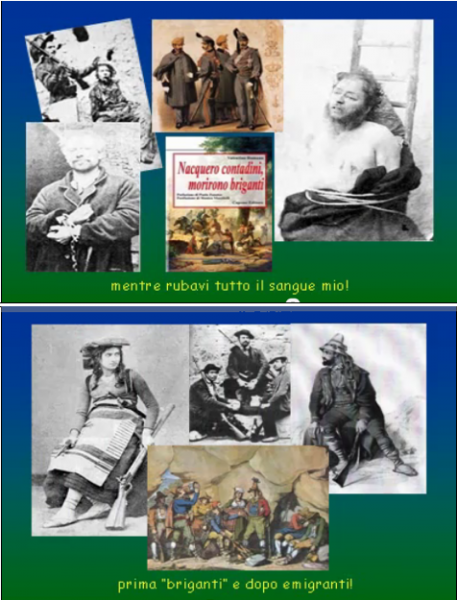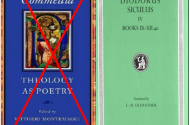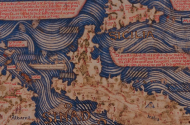Preface Descriptions vs. Representations
Silvana Patriarca writes:
“I will not invoke reality, but will focus my attention on what today's social scientists would call "hard data," i.e. quantitative information, and treat them as a representation.”
(“How many Italies? Representing the South in Official Statistics” in Italy’s ‘Southern Question’ ed. Jane Schneider – emp.+ p78)
Nelson Moe writes:
“The bulk of this study examines the way the south was represented in the decades before and after unification...”
(The View from Vesuvius: Italian Culture and the Southern Question p. 2 emp.+)
Note: the common use of the word “representation(ed)”; they do not say descriptions.
Patriarca’s readers should not assume that the “hard data, i.e. quantitative information” is accurate (truthful) descriptions of the reality of southern Italy, during the years of the Patria Meridionale Brigandage War (aka Risorgimento).
Similarly, readers of Moe must not confuse “the way the south was represented” with the way the south was described.
Descriptions are true or false empirical propositions, either accurate or not accurate.
Representations are metaphoric statements; they are epistemologically empty (neither true or false)– i.e. they convey no knowledge of the object under consideration. Representations tell us about the subjective opinion (value judgment) of the person making the representation.
Students of Italian southern history must become very aware of and sensitive to the distinction between ‘descriptions’ which are the facts of history, and ‘representations’ which are the propaganda of hegemonist.
------------
Silvana Partriarca History of the Mezzogiorno as “Lies, Damn Lies and Statistics”
In her article, Professsor Partriarca discusses the 1861 Census of Italy, which she describes as:
“The most important statistics of the first decade of existence of the new state were undoubtedly those on population...The census formed the basis of any statistical and economic inquiry... demographic data served as the principal indicator of the condition of the country" (emp.+ p79)
Note the phrase: “principal indicator of the condition of the country".
Again, as with the word representation, professor Partriarca uses the word “indicator” and continues to eschew the word ‘description’ or ‘measurement’. She does not say: “demographic data is the principal “description’ or ‘measurement’ of the condition of the country.”
When, if fact, a census consists of descriptive statements of demographic Reality; i.e. the census is a collection of statements that describe the characteristic of the population –i.e. the population reality.
Descriptive statements are either accurate (true) or not accurate (false). If, for example, the U.S. census document reports that “seventeen million Americans are of Italian descent”, then that statement is either accurate (true) or not accurate (false).
However, in her own words, Professor Partriarca is not interested in reality; i.e. not interested in the truth or falsity (accuracy or inaccuracy) of the statements in the 1861 Italian census.
And, probably for very good reasons – the 1861 census of Italy south of Rome, unless and until empirically demonstrated otherwise, has a very high probability of being a worthless description of southern Italian reality; a classic example of Mark Twain’s adage: “Lies, Damn Lies and Statistics”.
The sole purpose of the 1861 Census is to function as a Piedmontista hegemonic tool to negate the Reality of the state of ‘The Two Sicilies’, hegemonically destroy the culture of southern Italy and meld it into the Piedmont culture.
It is a classic exercise in hegemonic destruction of the Patria Meridionale cultural by its dialectical Piedmontese Other. This is evidenced by the fact that the compliers and publishers of the census did not distinguish between northern and southern Italy.
Patriarca: “ ‘North’ and ‘South’ did not appear as reporting units in the official statistical publications of the 1860s” (p. 81 emp +). In short, “Patria Meridionale” did not exist as far as the Piedmontese compliers of census were concerned.
Further, the uselessness of the 1861 Census as description of southern Italian society in the year 1861 may be logically inferred without empirically reading the document, by testing it against general standards of census taking. Consider the following:
Reality and Census Documents
Recording Descriptions of the People
Below is a drawing depicting a 19th century census taker. There are two aspects of this picture that are significant for purposes of this discussion.
First, the Census taker is the man with the pen and paper. He is creating a Document.
Second, the People gathered around the census taker are The Reality that is being described (recorded) in the census Document.
In short, the census taker is creating a document purporting to describe some demographic characteristics (reality) of that community at that point in time.
Keeping in mind the most fundamental precept of critical historiography: “with pen and paper one can write anything”,
- the question that students of southern Italian history, who are interested in the Reality, at the time of the Risorgimento, should ask:
“How accurate are the descriptions recorded in the 1861 Census”?
Are the ‘descriptive statements’ TRUE or FALSE?
Further, consider the idyllic character of the depicted scene. The scene accurately implies that the “hard data” (to us Partriarca’s words), is willingly (indeed happily) provided to the census taker.
The only access the census taker has to the “hard data” is from information provided by the people; there is no documentary verification. For example, the census taker asks a person their age. The statement that the person makes is recorded as ‘fact’; there is no birth certificate provided to verify the person’s age.
If the people are not willing to give him accurate information,
- than the census is not an accurate description of reality; the census document is a false (inaccurate) description of reality.
Accordingly, when considering the census of the Italy south of Rome in the year 1861, the historian must make a judgment as to how confident to be about the accuracy of the data; which, in turn, requires a judgment of how confident about the willingness of the people to cooperate with the census taker.
In as much as the South was in the process of being conquered, brutalized and dehumanized in the year 1861 by the Piedmont Army,
- how reasonable is it to judge that the people of the South were willing participants providing accurate information to the census takers?
Consider, the following descriptions of life in the South at the time of the census reported by historian John Dickie (Darkest Italy) and ask yourself:
Does this sound like the type of environment that people willing meet with and provide accurate information to a census taker?
“Parliamentary commissioner Nino Bixio wrote in 1860: ‘this is a country that should be destroyed or at least depopulated and its inhabitants sent to Africa…” (p. 35 emp.+)
(Of course we know now that Nino’s wish for depopulation came true starting in 1870 and continued till 1920. Only the people went to the Americans instead of Africa.)
“The Mezzogiorno spent the first five years after incorporation into the new Italy under different forms of what was essentially a military regime…A very difficult situation developed into near anarchy in the Spring of 1861… (p. 37 emp.+)
“One of the most infamous instances of pitilessness was the razing of the town of Pontelnadolfo whose inhabitants had deceived and butchered a column of troops. (p. 41 emp.+)
“Unauthorized, brutal measures such as mass arrest, summary executions, and reprisals had been used from the start by the Piedmontese army against lawbreakers and rebels… (p. 31 emp.+)
“The many grisly ‘hunting-trophy’ photographs of the condemned or executed taken by army officers… (p. 33 emp.+)
“...the infamous Pica law was passed that grafted transportation onto the system of punishments…” (i.e. the peasants were physically removed from their communities p. 41 emp.+)
Given those descriptions of life south of Rome at the time of the census,
- How can anyone take the ‘1861 Italian Census of southern Italy’ seriously, indeed characterize it as scientific “hard data”?
The 1861 Italian census adds new meaning to Twain’s:
“Lies, Damn Lies and Statistics”
It is a logically valid inference to conclude that:
The only purpose that the Census Report of Italy in 1861 served was the obliteration of Patria Meridionale culture from the historic record of Italy.
And, so very sad to say:
A Piedmontista teacher could use a high Chair of Wisdom (Ivy League) to foist upon seventeen million American Terroni such a gross misrepresentation of their history.
Nelson Moe The Historiography of ‘Representation’
In two articles about southern Italy,
“The Emergence of the Southern Question in Villari, Franchetti, and Sonnino” in Italy's Southern Question: Orientalism in One Country 1998,
“‘This is Africa’: Ruling and Representing Southern Italy, 1860–61” in
Making and Remaking Italy: The Cultivation of National Identity around the Risorgimento 2001
totaling 61 pages of text, Professor Moe uses the word represent or representation 39 times, for an average of once every 1.5 pages (61/39=1.5). This is to say: the word represent or representation appeared (on average) at least once on every one and a half pages.
Accordingly, I think it is fair to characterize Professor Moe’s works as Historiography of ‘Representation’. Namely, he is writing the history of Italy south of Rome based on documents that, in his favorite word, represent the Italian south. Further, all the representational documents he presents in these articles were written by Piedmontista bent on the destruction of the Patria Meridionale culture.
Indeed, the Villari, Franchetti, and Sonnino “representations” bring to mind images of missionaries traveling among the ‘great un-washed’ south of Rome preaching the Pietmontese Gospels. This the what American students of southern-Italian descent can expect at the crème de la crème of the American university system.
Again, as discussed above at some length, a representation should not be confused with a description. Statements of representation cannot be evaluated for truth or falsity. Further, truth and falsity are the criteria used to establish factual knowledge.
In short, Professor Moe, like Professor Patriarca, sitting in an Ivy League Chair of Wisdom, provides a wealth of documents containing the subjective “representations” made by the enemies of the Patria Meridionale, but he is lite on verifiable factual knowledge claims about the history and culture of the people south of Rome.
Italian Studies Programs Italy =Arno River Valley
Italian Studies programs in American universities do not bother with facts or representations of Italy south of Rome. They just flat-out ignore Italy south of Rome. Indeed, Italy in those Chairs of Wisdom consists of a couple of centuries of art and literature produced in the Arno River valley. (I have written about Italian Studies Programs in two previous articles linked at the top of the page in the "Related Articles" box.)
In Conclusion
It is accurately said: “History is Written by the Victors”. The voluminous number of documents Professors Patriarca and Moe cite in their works were written by “the victors”.
The Piedmontista militarily defeated the state of the “Two Sicilies” and hegemonically overwhelmed its historic culture. Today the word “Italy” largely means what the cultural progeny of the original Piedmontista say it means.
However, it does not necessarily follow that contemporary historians have to believe the representations made by the dominating party in dialectical clashes between persons, states, cultures, etc. It is possible to gain objective knowledge of both parties to dialectically clashing states and cultures by applying the empirical and logical principles of ‘critical historiography’ (see: Marc Bloch’s The Historian’s Craft - also 'linked' article on Bloch & Patriarca). And, it is possible to write objective history of both parties in the dialectical process, rather than “sing the songs” of the dominating party.
Sadly, for American Terroni, the professors sitting in the high Chairs of Wisdom largely do not see the role of contemporary historians as seekers of object knowledge and accurate factual descriptions of the Patria Meridionale historic realities.
And so, one wonders...
How do southern-Italian American students gain accurate factual knowledge of their history and culture given that the Chairs of Wisdom are so biased against them?
“Aye Now! ... There’s the Rub – eh?”
And, therein lies the meanings of:
‘Orientalism’, ‘Cultural Hegemony’ and ‘Master-Slave’.













Every article I find on this
Every article I find on this site makes me think less and less of it and makes me realize you are not publishing academia rather distorting reality to prove your thesis. so many inconsistencies throughout it all, where to begin? you rave about the piedmontista's cultural hegemony, and how they control italy's image, yet you ignore the fact that the country's de facto language is from tuscany, capital is in rome, and recognized food comes from the south. how exactly is piedmont ruling image again? are they purposefully omitting themselves? *awaits some thesis about how americans eating pizza is the North's symbolic gesture of insulting the South* MANY more people have heard of Naples than Torino. Your self pity and pandering ranting are just too far off base.
Yet one more fit of
Yet one more fit of belly-aching for the pretended “neglect” of “Southern Italian culture” in the USA, and for the also pretended “imposition” of the culture originated in the upper part of the peninsula throughout the world in the presentation and consideration of Italian culture at large. This time, Mr Verso laments that “the history and culture of seventeen million Americans of southern Italian descent is invisible in high school and college Italian Studies curriculums.” Evidently, it does not penetrate certain skulls that the salability of products depends on several factors, the most important of which are their quality, their presentation, the quality/price ratio. What is taken into consideration in this writing is ITALIAN, not “Italian-American” culture: “Italians” and “Italian-Americans” are altogether different faunas, they have nothing to do with each other with the exception of a more or less recent, more or less remote geographical provenance, some far-off parentage and ancestry. If “Italian-American culture” (identified, as customarily, by Mr Verso with Italian Southerners-cum-Sicilians) has made itself un-noticeable, it may very well be that its products haven’t made themselves worthy of attention in the USA in the context of general American culture. If that has happened – as, apparently, it has -, if Italian-Americans have not been able to make themselves appreciated in the field of culture, it certainly is not the fault of a “Northern domination” and of an imposition of the culture of “Renaissance history - that sliver of Italian history on the Arno”. That “sliver”, as Mr Verso disdainfully calls it, with Firenze as its main center, has been the place of origin of the cultural phenomenon known as the “Renaissance”, originated not only from there, in Milano, Venezia, Roma, the whole of Northern and Central Italy and exported to the whole rest of the known civilized world which, at that time, was Europe. It “IMPOSED” itself there, was eagerly gobbled up everywhere and underwent the local processes of assimilation. A great factor has been the neglect and repudiation of the Italian language on part of most Italian immigrants. That cannot be blamed on Northern-Central Italians. The matter of the language has already been discussed in Mr Verso’s blog (”The death of the Italian language in America”, December 26, 2007). The reason for this death was only the language was given up by the negligence and the “don’t-give-a-d**n” attitude on those who should have kept it living. Now, Mr Verso opposes Professors Nelson Moe (Columbia U., NYC) and Silvana Patriarca (Fordham U., NYC), calling the latter “Piedmontista” (maybe he means “Piemontese”, please get at least A MINIMUM of knowledge of Italian, Mr Verso, before debating on things Italian) because they’ve published a book that doesn’t toe the line of unconditional, total admiration for that Italian South(Sicilia he’s in such an awe of. YES, Mr Verso, Silvana Patriarca IS from Piemonte, precisely from Gattinara, province of Vercelli, the site of production of one of the best wines in Italy (similarly to nearby Ghemme). Is that a fault in your eyes, an element for belittling her? Sorry, I put more truck into HER (AND Moe’s) culture, competence and objectivity, than in yours – also because, Mr Verso, of “objectivity” you have NOTHING. What you mostly show is racist bile “in reverse”. So, Americans of Italian descent and with Italian-derived surnames, if you want some recognition of your “culture”, hitch up your pants, girdle your loins and start putting out something of merit. Don’t keep whimpering about being neglected and/or ignored, pleading and clamoring for subventions, payouts, subsidies to keep yourselves afloat. Maybe you’d also start being more respected as an ethnia – which, apparently, you are NOT.
South of Rome–West of Ellis Island | i-ITALY
When you remain approved for a loan the total amount of money yourself are borrowing is simply automatically deposited on the inside the bank profile you provided in relation to your application. You really need not need a day off from your medical office to visit that this money lender.
South of Rome–West of Ellis Island | i-ITALY
Having read this I thought it was extremely enlightening.
I appreciate you spending some time and effort to put this informative article together. I once again find myself spending way too much time both reading and commenting. But so what, it was still worth it!
South of Rome–West of Ellis Island | i-ITALY
I used to be suggested this website through my cousin. I am not positive whether this submit is written by way of him as no one else realize such exact about my difficulty.
You are incredible! Thanks!
South of Rome–West of Ellis Island | i-ITALY
You can definitely see your expertise within the work you write. The world hopes for more passionate writers such as you who are not afraid to mention how they believe.
Always go after your heart.
South of Rome–West of Ellis Island | i-ITALY
Way too they need to borrow instantly all through case of emergency. Thus, don't give them incorrect contact information.
South of Rome–West of Ellis Island | i-ITALY
hi there, homepage. Great info about payday loans.